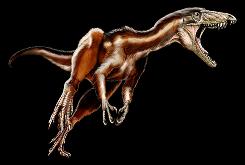
In the journal Science, a team led by Sterling Nesbitt of the American Museum of Natural History in New York, unveils Tawa hallae, found in a fossil bone bed near New Mexico's Ghost Ranch, made famous by the artist Georgia O'Keefe. Nesbitt's team named the creature, a 6.5-foot-long meat-eating precursor to T. Rex, after a Pueblo sun god and the fossil collector Ruth Hall.
"Tawa helps us reconstruct the origins of all the most primitive dinosaurs, suggesting they were likely located in South America," Nesbitt says. The dinosaur, "probably ate anything he got his hands on," he adds.
Tawa lived some 215 million years ago, when South America abutted North America and Africa on the super-continent Pangaea, since separated by the drift of the Earth's crustal plates. The fossils - two nearly complete skeletons and parts of six others - possess the claws, skull and bones of the first dinosaurs from about 230 million years ago found in South America. The fossils fill in evolutionary gaps to later "theropods", the two-legged, upright meat-eaters such as T. Rex, which lived about 80 to 65 million years ago, and today's birds.
"We've got to rewrite some chapters in textbooks, and I have to rewrite my next lecture" says paleontologist Thomas Holtz Jr. of the University of Maryland in College Park. Holtz and some paleontologists had argued that some theropods originated in North America, but Tawa displays clear links to earlier South American ones and to later ones found in Europe, jammed against North America at that time, he now says. "All carnivorous dinosaurs are relatives, this suggests," he adds.
Tawa and other early dinosaurs spread through a world dominated by crocodilian reptiles of all shapes and sizes, including very large carnivores, Nesbitt says. Only after the end of the Triassic era some 200 million years ago, a time of a major extinction among species, did dinosaurs flourish and grow to their massive size. "Tawa would have looked like a very small T. Rex," Nesbitt says, adding "no one would have guessed then," that the theropods would later give rise to massive multi-ton killers millions of years later.
The Tawa finds all likely died in a flood that tangled their bones with other creatures. The find also sheds light on origins of other dinosaur lines, the study says, including the "sauropods," four-legged, long-necked, long-tailed plant-eaters, which don't turn up in North America fossil beds from that era, but do in Europe. Their rarity points to a South American origin for all dinosaurs, not just T. Rex's lineage, Nesbitt says. "Sauropods just avoided the tropics," of then-North America, some 215 million years ago.



Reader Comments
to our Newsletter